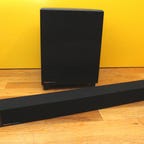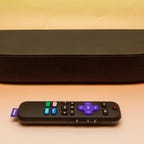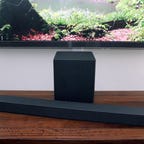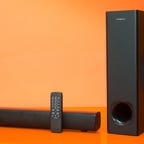Best Soundbar for 2024
If you're looking to upgrade your TV speakers, these are the best soundbars you can buy.
Our Picks
While many TVs have a decent sound system, getting a speaker for your living room setup totally changes the viewing experience. With the right soundbar, you can get all the quality of a home theater or AV receivers without taking up as much space. We have tried out many of the big-name brands in sound including Sony, Sonos, Bose, Vizio and more to discover who delivers the best sound for your needs.
What is the best soundbar overall?
The $130 Roku Streambar is the best soundbar for the money.
If you're looking to spend the least amount of money on quality sound, then the best soundbar to buy is the Roku Streambar. It offers both streaming and sparkling movie sound and is an unbeatable value.
If you're looking for a step up from that, then the best soundbar for most people is the Klipsch Cinema 400. This Klipsch speaker adds the oomph of a wireless subwoofer, which will help you get the most out of action films and music. Taking this one step further, the Vizio M512a-H6 with Dolby Atmos support is an excellent buy for under $500, and the best option for spatial audio on a budget. Lastly, if you want the best that money can buy, then the Sennheiser Ambeo will give you the best sound I've ever heard in a soundbar.
If you're on the hunt for the best soundbar 2024 has to offer, I've rounded up some excellent speakers starting from $100. This list is updated periodically as I test new models.
Best soundbars of 2024
Easily supplanting my previous favorite, the JBL Bar 2.1 Deep Bass, the Klipsch Cinema 400 adds great design and an even bigger wireless subwoofer. Sound quality is still king, with a real sense of dynamics and excellent music replay. If you want to make your TV the next best thing to a movie theater, this is one of the most affordable ways to do it.
Best budget soundbar, best streaming video
Roku Streambar
While I really like the Roku Streambar Pro, the Roku Streambar does essentially the same job for $50 less. With a full-fledged 4K HDR Roku streamer built in and a single voice remote controlling everything, this bar gives you audio and video in one simple bar. The Roku soundbar setup is a breeze; just add it to a TV with a simple HDMI port connection. This affordable soundbar has sound quality that's acceptable for the size and price, and you can add a $129 wireless subwoofer for more punch.
Best soundbar under $200
Vizio V21
If you're looking to ditch your TV speaker, this is where I suggest you start. The subwoofer may be smaller than usual for the brand, but this audio bar still sounds great, as well as offering HDMI connectivity with ARC and a much easier-to-understand input display. The Vizio V-Series 2.1 is the best soundbar value I have tested in the last few years.
Best soundbar under $100
Creative Stage
For less than a C-note, the Creative Stage soundbar offers a bunch of previously unheard-of features, including HDMI connectivity with an HDMI ARC port and a subwoofer. What's even more remarkable is that this affordable PC soundbar sounds better than most of its ultra-budget competition; its wired subwoofer fills the room with great bass. The soundbar includes a variety of audio modes, making it quite versatile, and the speaker delivers excellent sound quality for gamers and movie fans alike.
Best inexpensive soundbar for music
Sonos Ray
Sonos' new entry-level soundbar offers a lot for the money, including the company's excellent multiroom music system onboard. A two-channel soundbar with Dolby Digital decoding, the Ray is roughly two-thirds the size of the Sonos Beam, yet it delivers a surprisingly wide soundstage.
While it doesn't support Dolby Atmos surround sound or have an HDMI port to connect to your TV (you use the included optical cable instead), I was impressed with the sound quality for music and movies. You can pair it with a couple of other Sonos speakers like the Ikea Symfonisk, or even the new Sonos Sub Mini, to create a surround sound system.
Best Dolby Atmos soundbar under $500
Vizio M512a-H6
A true step up from the preceding soundbars, the Vizio M512a-H6 is the most cost-effective way to get true Dolby Atmos playback. This surround system includes the main soundbar with up-firing height speakers built in, a 6-inch subwoofer and two wired rear speakers. That's a lot of parts, but it was easy to set up, and I was impressed with the overall build quality. Most importantly, it offers excellent performance with movies, including real Atmos effects I could hear, as well as music. The M512a-H6s lacks Chromecast and AirPlay streaming but still earns my hearty recommendation both for home cinema fans and for people looking to listen to their favorite album (whether in Atmos or not).
Best soundbar if money's no object
Sennheiser Ambeo Max Soundbar
If you simply must have the least number of boxes and remotes in your living space and yet demand the best Atmos quality sound performance you can get, this Sennheiser speaker is your baby. It's a single unit, without a subwoofer, but it's able to conjure up the most realistic overhead and true surround-sound effects I've ever heard. It's also controlled entirely via remote control. It's not a cheap piece of sound equipment, but it's comparable in price to a full set of surround speakers without the bulk and with 85% of the great sound and performance. It's now been joined by the cheaper Ambeo Soundbar Plus.
Best all-in-one soundbar under $1,000
Sonos Arc
If you're interested in setting up a multiroom sound system, a Sonos soundbar system is still the best option. The Sonos Arc is the company's best soundbar and includes Dolby Atmos playback, a class-leading music ecosystem, and Google Assistant and Amazon Alexa built into the bar itself. The soundbar system sounds good with music and movies, and adding a pair of Ikea Symphonisk bookshelves should really boost your home theater sound experience. The Arc sounds a lot bigger than the cheaper Beam, and the smaller speaker needs the $700 subwoofer to make it comparable in terms of sound.
Best soundbar with Alexa
Yamaha YAS-209
The Yamaha YAS-209 offers excellent sound quality in a compact soundbar. Built-in Amazon Alexa voice control is useful, allowing this smart soundbar to stream music, and the mics work well in loud environments. The soundbar's implementation of DTS Virtual:X virtual surround sound offers a rich effect reminiscent of surround speaker sound. Two HDMI connections are included, one with HDMI ARC. This smart soundbar's wireless subwoofer is more articulate and offers more headroom than the competing, and also excellent, Polk Command Bar. The Yamaha soundbar YAS-209 doesn't use the company's MusicCast system, so it won't sync up with other Yamaha speakers.
Best soundbar under $1,000
Vizio Elevate
The Vizio Elevate's main draw may be its motorized-height speakers, but once you get over their novelty, you'll find that the speaker system also sounds great. The separate sub and height-enabled rear speakers really help pull this Vizio soundbar ahead of the Sonos Arc sonically. With Dolby Atmos, DTS:X and Chromecast built-in, multiple HDMI inputs and Bluetooth, the only thing the Vizio doesn't provide is Apple AirPlay support.
Factors to consider when choosing a soundbar
When choosing which soundbar to buy, CNET also uses the following criteria as part of its selection process:
- Price: The most important consideration when choosing a soundbar is how much it costs, and I have found there are great soundbars at every price level, starting at $100 and up. I give a lot of thought to the features a soundbar has in comparison to others that cost the same. I do have one rule of thumb: Once the price of a soundbar exceeds $500, you may find it more worthwhile to save for an AV receiver and speakers.
- Wireless streaming: Whether it's connecting a phone over Bluetooth or more advanced streaming technologies such as Spotify Connect or Apple AirPlay, the more choices for streaming technologies a soundbar has, the better.
- Dolby Atmos: Dolby Atmos is one of the most popular features in soundbars over $400, and so I look at features that help maximize spatial sound quality. For example, does the soundbar offer dedicated height speakers, or is it simulated Atmos? See my roundup of the best Dolby Atmos soundbars.
- HDMI connections: At the bare minimum, a soundbar sold in 2024 should have at least one HDMI input, and preferably more. The ability to offer multiple HDMI ports will help users with a large selection of sources (Xbox Series X, Apple TV, Nintendo Switch, Blu-ray player, etc.). There are notable exceptions to this rule. For example, the Sonos Ray only offers an optical output, but this is acceptable given that it's most suitable for older or smaller TVs.
- Subwoofer and surround speakers Single-bar systems are great for smaller TVs, while a soundbar-and-subwoofer combo is better suited for a living room. For that reason, I take note of the size of the system and whether it offers wireless or wired peripherals. Most soundbars with subs are wireless, for instance, while systems with surround can be wired, as in the case of the Vizio Elevate.
Read more in the soundbar buying guide.
How CNET tests soundbars
At the AV Lab in New York City, I test soundbars head to head with a variety of reference equipment.
CNET follows a rigorous, unbiased evaluation process for all of its soundbar testing, from simple stereo speakers to Dolby Atmos systems. In the CNET AV Lab, I do comparative testing, pitting similar soundbars against each other side by side.
I evaluate the performance of each soundbar with several different types of content, including movies, music, TV shows and games. I use several test scenes -- including the opening of Mad Max:Fury Road for playback of the spatial audio standard Dolby Atmos for soundbars that support it. I also use the Thanator Attack scene of Avatar (26.53) to test a system's dynamics and detail retrieval.
When it comes to music, I use several CNET test tracks which you can find here in a Tidal or Spotify playlist. Tracks such as Nick Cave and the Bad Seeds' Red Right Hand, with its deep bass and tenor vocals, help determine a system's ability to track male voices in particular, without sounding congested. The song also helps with uncovering hidden details and the relative dynamics a speaker is capable of. Using both types of content -- movies and music -- I then grade the sound quality of each soundbar. I evaluate characteristics such as speech clarity, dynamics/volume, bass response and musical playback.
CNET's dedicated audio lab in downtown New York includes a selection of recent televisions (with HDMI eARC), plus Apple TV 4K streamer and Roku Ultra streamer, a Microsoft Xbox Series X and an Oppo UDP-205 4K Blu-ray player. I also use Roon music software to stream to individual devices or the Oppo player as needed.
Other soundbars we've tested
The Bose Smart Soundbar 600 is a $500 Dolby Atmos soundbar.
- Bose Smart Soundbar 600 ($450): Bose makes several excellent soundbars including the Smart Soundbar 600 which offers true Dolby Atmos playback. The 600 is great for reproducing dialogue and sounds fine with music too. The Sonos Beam squeaks barely ahead due to better bass and the tried-and-true Sonos ecosystem. Read CNET's review of the Bose Smart Soundbar 600.
- JBL Bar 500 ($600): Alongside Klipsch, JBL has long had a reputation for being a rock 'n' roll brand with a big sound and even bigger cabinets. During my tests, the JBL Bar 500 fulfilled both parts of the brief by pairing excellent sound with one of the largest subwoofers I've ever seen with a soundbar. Yet, while it includes both HDMI and networked music streaming, the JBL is missing Dolby Atmos -- which is disappointing for the price. You can save yourself a lot of money by getting the even bigger-sounding Klipsch Cinema 400 instead.
- Polk Signa S3 ($299): If you're looking for a speaker that can do music as well as play the latest episode of The Last of Us, then the Polk Audio Signa S3 has a lot to offer. It's great for streaming, as it has Chromecast built-in in addition to Bluetooth and an HDMI input. Read my Polk Signa S3 review.
- Sony HT-S2000 ($498): Better in some ways than the competition and worse in others, the Sony HT-S2000 boasts a better bass response than the Sonos Beam. For $500 it misses a lot of the features of its single-bar competition, namely Dolby Atmos compatibility and Wi-Fi streaming. Can now be found on sale for closer to $300 from time to time.
- Zvox SB500 ($450): If you're looking for a single audio bar that's even cheaper than the Sonos Arc, the Zvox SB500 is a great option for people who still prize sound quality. This speaker offers multiple sound mode options, tighter bass and better sound than most other single-speaker options. While it may lack the Sonos' Wi-Fi streaming, the Zvox still includes Bluetooth connectivity for streaming audio from your phone or tablet. Read the Zvox SB500 review.






